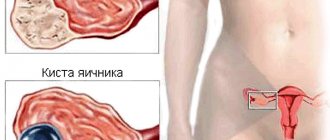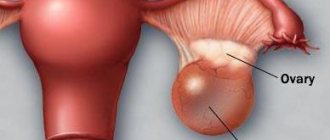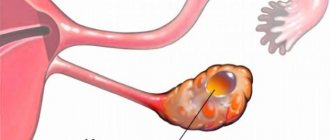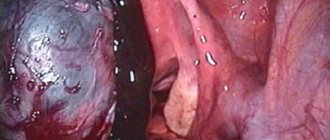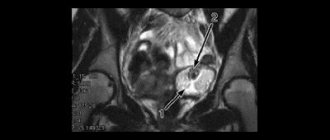The term cystoma was widely used in Russian-speaking countries to describe ovarian tumors originating from epithelial tissues and having proliferative activity. Its main difference from cysts is that a cyst grows due to cell division, and not due to the accumulation of fluid in them. This term does not appear in English-language literature, and is currently considered an anachronism.
- Reasons for the development of ovarian cystoma
- Classification
- Symptoms of ovarian cystoma
- Diagnosis of cystoma
- Treatment
- Prognosis and prevention
- When does a cystoma transform into cancer?
- Is it possible to get pregnant after removal of an ovarian cyst?
- Cost of cystoma treatment
Most often, cystomas are found in women over 30 years of age, and half of the patients with this pathology occur during menopause, when ovarian function declines.
One of the distinctive features of a cystoma is its rapid growth, which is why it can reach gigantic sizes. Anatomically, the neoplasm is a tumor connected to the ovary by a pedicle, which contains ovarian ligaments, uterine and ovarian blood vessels, lymphatic vessels, and nerves.
Reasons for the development of ovarian cystoma
The exact reason why cystoma develops has not been established. There are several theories, among which the most widespread are hormonal, viral and genetic.
Today it is customary to talk about risk factors, the presence of which increases the likelihood of developing this tumor:
- Hormonal problems.
- Hereditary predisposition.
- Infection with herpes viruses type II and HPV.
- The presence of chronic gynecological diseases - endometritis, inflammatory processes.
- Menstrual irregularities.
- History of breast cancer.
- A history of ovarian surgery.
- Termination of pregnancy, both spontaneous and medical.
- A history of ectopic pregnancy.
The main risk group consists of premenopausal and menopausal women who have the above risk factors. In this regard, they are recommended to undergo regular examination by a gynecologist.
Danger during pregnancy
It is observed during pregnancy and removal occurs after childbirth.
It is advisable to identify and remove the cyst before planning, since it often causes miscarriages, missed abortions and other complications. Doctors avoid performing surgeries on pregnant women, as this also leads to miscarriage or developmental abnormalities in the fetus.
In most cases, they take a wait-and-see approach and monitor any changes that occur. After childbirth, removal of the multi-chamber capsule is indicated. In rare cases, when there is a direct threat to the life or health of the patient, surgical intervention during pregnancy is prescribed.
An ovarian cyst, consisting of several capsules, poses a danger to a woman at any age. Once identified, it must be immediately removed surgically. The exception is small tumors, which are tried to be cured using conservative methods.
Classification
There are several types of cystoma classification. Depending on the tendency to malignancy, the following are distinguished:
- Benign cystomas.
- Proliferating cystomas. They can develop into cancer.
- Malignant cystomas are malignant.
It should be noted that during their existence cystomas can transform from one type to another. Thus, benign tumors can turn into proliferating ones, and from them ovarian cancer develops.
Based on the nature of the contents of cysts, the following types are distinguished:
- Serous cystomas. They are usually single-chambered and filled with serous fluid. They can grow to gigantic sizes, more than 30 cm. They degenerate into cancer in 10-15% of cases.
- Mucinous cystomas. Such tumors, as a rule, contain several chambers filled with mucus-like mucinous secretion. The probability of their malignancy is 3-5%.
A cystoma can affect one ovary or two, and these will not necessarily be tumors of the same type. However, mucinous neoplasms more often affect one ovary, and serous neoplasms both.
Treatment of multi-chamber (three-chamber) ovarian cyst
The issue of therapy is approached based on the size and type of the disease, the characteristics of the formation of the tumor, and the age of the patient. Among the features of treatment are the following factors:
- If a functional neoplasm is detected in the ovaries, the dimensions of which do not exceed 5 cm, medical supervision is recommended. Often the tumor disappears on its own. The operation is indicated only in case of exacerbation of the situation, when the cyst ruptures or it turns over.
- When it is confirmed that a multilocular cyst has the appearance of a paraovarian, serous or mucinous tumor, drug treatment is useless. Since rupture is inevitable, these forms of pathology require surgical intervention. Often serous or mucinous cystadenoma can degenerate into oncology, so delaying surgery and self-treatment is unacceptable;
- Surgery is performed simultaneously with the prescription of hormonal drugs and contraceptive methods to prevent the onset of relapse of the pathology.
Surgery as one of the reliable methods of getting rid of a cyst
The option of surgical intervention is chosen based on the type and size of the formation, and the risk of developing oncology. Timely surgery helps the ovaries preserve their functionality, so women successfully become pregnant after it.
Laparoscopy
The operation is performed through a small incision in the peritoneum, which looks like only three punctures measuring up to 10 mm. A similar operation is indicated for tumors whose dimensions are less than 8 cm, which are certainly benign. At the time of the procedure, the cyst is removed by enucleation. The ovaries are not affected during the intervention.
Abdominal surgery
An abdominal operation such as laparotomy is performed through a transverse incision up to 15 cm long at the bottom of the peritoneum. It is indicated when large growths are detected, as well as when there is suspicion of oncology. The completion of the intervention is the patient’s hospitalization for a week.
Ovariectomy
If malignancy develops, oophorectomy is required. This procedure involves the complete removal of the ovaries. It is performed only in a situation where the patient’s life is threatened.
When the operation is completed, the production of androgens is significantly reduced, which affects the woman’s performance and well-being. The duration of the intervention is up to 4 hours. Several types of operation have been developed:
- removal of the entire fallopian tubes;
- excision of one ovary;
- removal of both appendages.
Puncture treatment
Sometimes puncture of the cyst is justified, when a special substance is injected into the cavity of the formation. It causes tumor regression, although in a multi-chamber situation this option must be treated with caution.
The intervention is associated with technical complications, since many partitions are present. It is difficult to exclude oncology, but it is impossible to take a biopsy, since only the contents of the capsules can be examined.
To perform a puncture, you must strictly follow the indications. You cannot use this technique if you have inflammation or a suspected dermoid or endometrioid cyst.
Is it possible to do without surgery?
Although extremely rare, there is a possibility of influencing the tumor without surgery, preventing the development of many cells. Recommend:
- promptly treat genital inflammation;
- take hormonal medications only on medical advice;
- maintain a healthy lifestyle.
What can you do during pregnancy?
When a cyst is discovered before conception, it is necessary to first remove it and then plan a pregnancy. If a tumor is detected during pregnancy, management tactics are as follows:
- before the middle of the term, a dynamic ultrasound is performed, tumor markers are checked to exclude oncology;
- if the cyst does not disappear, surgery is recommended;
- when the formation is first detected after mid-pregnancy, the tactics are individual.
Symptoms of ovarian cystoma
Small cystomas are asymptomatic and are detected during examination for other gynecological pathologies, for example, infertility. It is also not uncommon for such tumors to be detected during preventive examinations during ultrasound of the pelvic organs.
The main symptoms occur when the tumor reaches a large size, and they are usually associated with the fact that the tumor displaces internal organs. In this case, patients may present the following complaints:
- Pain in the lower abdomen, aching or stabbing in nature, which can radiate to the groin or lumbar region.
- Acute pain. Acute pain may indicate hemorrhage into the wall of the cyst, its rupture, or torsion of its legs.
- An increase in abdominal volume not associated with excess weight gain.
- Unpleasant sensations in the abdomen - heaviness, distension.
- Menstrual irregularities.
- If the tumor puts pressure on the bladder, you may experience frequent urination with a feeling of incomplete emptying of the bladder.
- When the rectum is compressed, constipation may occur.
- If compression of large blood vessels occurs, swelling of the lower extremities is possible.
- Large serous cystomas can lead to ascites (accumulation of fluid in the abdominal cavity) or hydrosalpinx (accumulation of fluid in the lumen of the fallopian tube).
Two-chamber neoplasm
A two-chamber cyst of the right or left ovary is a special formation consisting of only two chambers. It develops, like other types of tumors, as a result of severe hormonal imbalance (a surge in the production of both estrogen and progesterone), severe stress or physical exhaustion, as well as during pregnancy.
A small (up to 3 cm) two-chamber cyst has no symptoms and is usually detected during an ultrasound. As the tumor grows, a woman develops unpleasant symptoms such as:
- nagging pain in the lower abdomen - increases with exercise, stress, sudden weight loss or sexual intercourse;
- “daub” between menstruation;
- delayed menstruation;
- slight nausea in the morning, sometimes even accompanied by vomiting.
Most often, tumor growth is caused by hormonal imbalances - increased testosterone production, surges or drops in estrogen production. As a result, a woman develops hair on her chest and face, the hair on her legs becomes thicker and darker, and acne similar to teenage acne appears on her face.
Diagnosis of cystoma
In the absence of complaints, the presence of a neoplasm can be suspected during a gynecological examination and during an ultrasound scan of the pelvic organs.
With a bimanual examination, if the size of the tumor is sufficiently large, it is possible to determine its size, location, consistency, surface character, mobility, etc. A more informative method of examination is ultrasound, which allows you to clearly visualize the contents of the tumor, determine its relationship with surrounding tissues, differentiate the neoplasm from fibroids and other pelvic tumors.
Color Doppler mapping is performed for the differential diagnosis of benign and malignant neoplasms. Thus, in particular, cancerous tumors are well supplied with blood and have atypical venous blood flow and reduced blood flow resistance.
To make a final diagnosis, a diagnostic laparoscopy may be necessary, during which swabs are taken from the abdominal cavity and a biopsy of suspicious areas is performed. The final diagnosis is made only after surgical removal of the tumor.
Treatment
The generally accepted treatment strategy for patients with ovarian cystoma is surgical removal of the tumor. The correctness of this statement has been confirmed by numerous clinical studies, which indicate that true benign ovarian tumors cannot be cured conservatively and delay in their removal may result in malignant transformation or other complications that can have serious and even life-threatening consequences:
- Torsion of the neoplasm's legs.
- Capsule rupture.
- Leakage of cystoma contents into the abdominal cavity or pelvic organs.
The volume of the operation is determined by the following criteria:
- Patient's age.
- Her reproductive status.
- Histotype of formation and its size.
- Unilateral or bilateral lesion.
In young fertile patients with a low risk of cystoma malignancy, it is possible to perform a cystectomy - resection of the ovary along with the tumor. If there is an unfavorable histological type of cystoma in young patients, the affected ovary is removed. Postmenopausal patients with high and moderate risks of malignancy are recommended to undergo panhysterectomy - removal of the uterus and appendages.
Preference is given to laparoscopic (endoscopic) access. It reduces trauma, reduces the risks of developing adhesions and thromboembolism, and also allows the patient to recover faster. In the absence of conditions for performing this type of operation, as well as when the tumor is large, laparotomy access is used.
The first step in the operation is a visual examination of the tumor and inspection of the abdominal cavity for the presence of suspicious implants. If there is the slightest doubt about the benignity of the cystoma, an urgent cytological examination of swabs from the abdominal cavity and a histological examination of the tumor biopsy are performed.
If a borderline cyst is suspected, removal of the affected ovary, resection of the second ovary, resection of the greater omentum, as well as aspiration of intra-abdominal fluid, washings from all levels of the abdominal cavity and implant biopsy are performed.
Effect on pregnancy
If the tumor appears during pregnancy, the doctor, after diagnosing the hemorrhagic tumor, makes a decision based on the situation. A small pathology does not affect the bearing of a child, but if there is a risk of complications, surgical intervention will be required to remove the hemorrhagic cyst.
Possibility of conception
After laparotomy, the labia may hurt, and this, of course, negatively affects a woman’s intimate life. Over time, the pain will subside. Doctors do not recommend conception within six months after surgery.
The symptoms of a hemorrhagic ovarian tumor manifest themselves clearly, so it is impossible not to pay attention to this pathology. If you suspect the occurrence of such formations, you should immediately contact a gynecologist.
Although the pathology is considered a temporary functional disease that can go away on its own, complications can often appear without timely treatment, many of which can lead, I repeat, to death.
Prognosis and prevention
If the cyst is removed in a timely manner, the prognosis is favorable, and the patient has every chance of a full recovery. After surgery, it is necessary to regularly visit a gynecologist for follow-up examinations and treatment of concomitant pathologies.
Regarding the prevention of the disease, there is evidence that long-term use of oral contraceptives prevents the development of benign ovarian tumors. However, in order to exclude unwanted hormonal changes and related problems, it is necessary that the drug be selected by a qualified medical specialist.
The second point that plays a preventive role in preventing the development of ovarian tumors is the implementation of reproductive function. In this regard, artificial termination of pregnancy, especially the first one, is not recommended.
There is also evidence that women who have had a hysterectomy or tubal ligation are less likely to develop cystomas. The mechanism of this preventive action is not clear.
In general, for timely detection of changes in the ovaries, it is recommended to regularly visit a gynecologist and perform an ultrasound of the pelvic organs.
Reasons for education
Medical experts have not yet fully identified what contributes to the development of this disease. However, there is an opinion that cystic formation occurs as a result of the presence of diseases that provoke hormonal imbalance. In addition, development is associated with the following pathologies:
- Deterioration in the performance of the adrenal glands, thyroid gland, hypothalamus or pituitary gland;
- The presence of inflammation or infection in the pelvic organs;
- Genetic predisposition;
- Use of certain pharmacological drugs (emergency contraceptives, birth control pills, ovulation stimulants, etc.);
- Poor blood circulation in the ovaries;
- Medical abortion, miscarriage, ectopic pregnancy;
- Too early arrival of menstruation (before 11 years);
- Excess weight, anorexia;
- Serious mental disorders, constant stress and depression;
- Constant and intense physical activity.
Is it possible to get pregnant after removal of an ovarian cyst?
The possibility of spontaneous pregnancy is determined by the extent of the operation. With ovarian resection, which involves removing part of the organ, there is no significant loss of fertility. In a unilateral oophorectomy, one ovary is completely removed. The chances of spontaneous conception, although reduced, remain quite high. As a last resort, a woman may be offered to use the services of assisted reproductive technologies, for example, IVF.
After a panhysterectomy there is no chance of pregnancy. But it is worth noting that such operations are performed on postmenopausal women or patients with bilateral ovarian lesions, when other treatment options are not effective, there are risks of malignant transformation, and the patient’s life is at stake.
Complications
The duration of the recovery period is about 60 days. This time is enough for reproductive function to fully recover.
Complete loss of reproductive function occurs in the case of bilateral damage.
If the disease is not detected in a timely manner, as well as the lack of proper treatment, the likelihood of developing negative consequences increases significantly.
On this topic
- Female reproductive system
Can there be a delay and a positive test for an ovarian cyst?
- Natalya Gennadievna Butsyk
- December 4, 2021
Among the most common complications, even in the postoperative period, are:
- rupture of a cystic formation - there is a pronounced pain syndrome, release of fluid into the peritoneal cavity;
- metastasis to nearby organs;
- hormonal imbalance after surgery, which leads to excess weight, premature aging, psychosis and frequent mood swings.
In the absence of therapeutic measures, a papillary cyst often degenerates into a malignant tumor.
Cost of cystoma treatment
The cost of cystoma treatment is determined by the extent of surgical intervention, the presence or absence of concomitant pathology and many other factors. The exact price can be found out after a comprehensive examination and consultation with a doctor.
Doctors at the European Clinic have extensive experience in treating patients with cystomas, and a strong material and technical base makes it possible to choose exactly the method that allows you to count on the best possible result.
Book a consultation 24 hours a day
+7+7+78

